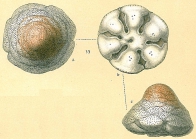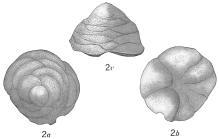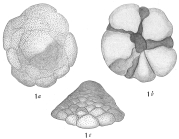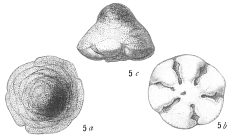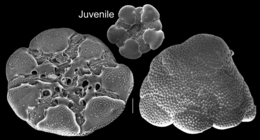Foraminifera taxon details
Cymbaloporetta Cushman, 1928
112138 (urn:lsid:marinespecies.org:taxname:112138)
accepted
Genus
Rosalina squammosa d'Orbigny, 1839 accepted as Cymbaloporetta squammosa (d'Orbigny, 1839) (type by original designation)
Pseudotretomphalus Hofker, 1979 · unaccepted (Subjective junior synonym in...)
Subjective junior synonym in opinion of Loeblich & Tappan, 1987
- Species Cymbaloporetta atlantica (Cushman, 1934)
- Species Cymbaloporetta bermudezi (Sellier de Civrieux, 1976)
- Species Cymbaloporetta bradyi (Cushman, 1915)
- Species Cymbaloporetta cifellii Banner Pereira & Desai, 1985
- Species Cymbaloporetta grandis (Cushman, 1934)
- Species Cymbaloporetta hemisphaerica Accordi & Selmi, 1952
- Species Cymbaloporetta mexicana McCulloch, 1977
- Species Cymbaloporetta panayensis McCulloch, 1977
- Species Cymbaloporetta plana (Cushman, 1924)
- Species Cymbaloporetta solida Shchedrina, 1984
- Species Cymbaloporetta squammosa (d'Orbigny, 1839)
- Species Cymbaloporetta squamosiformis McCulloch, 1977
- Species Cymbaloporetta tortonica Franzenau & Majzon, 1956 †
- Subgenus Cymbaloporetta (Millettiana) Banner, Pereira & Desai, 1985 accepted as Millettiana Banner, Pereira & Desai, 1985 (Opinion of Loeblich & Tappan, 1987 Nomen translatum)
- Species Cymbaloporetta bulloides (d'Orbigny, 1839) accepted as Tretomphalus bulloides (d'Orbigny, 1839)
- Species Cymbaloporetta cifelli Banner, Pereira & Desai, 1985 accepted as Cymbaloporetta cifellii Banner Pereira & Desai, 1985 (Subsequent incorrect spelling)
- Species Cymbaloporetta poeyi (d'Orbigny, 1839) accepted as Cymbaloporetta squammosa (d'Orbigny, 1839) (synonymy between R. squammosa and R. poeyi in Parker et al. (1871))
- Species Cymbaloporetta tabellaeformis (Brady, 1884) accepted as Cymbaloporella tabellaeformis (Brady, 1884)
marine, brackish, fresh, terrestrial
Cushman, J. A. (1928). Additional genera of foraminfera. Cushman Laboratory for Foraminiferal Research. <em>Contributions.</em> 4(1): 1-8., available online at https://cushmanfoundation.allenpress.com/Portals/_default/files/pubarchive/cclfr/4cclfr1.pdf
page(s): p. 7; note: Replace Cymbalopora a Cretaceous bryozoan genus according to Cushman. [details] Available for editors [request]
[request]
page(s): p. 7; note: Replace Cymbalopora a Cretaceous bryozoan genus according to Cushman. [details] Available for editors
Diagnosis Schizont test benthic, early stage trochospiral, low to moderately high conical, later chambers low and crescentic and...
Diagnosis Schizont test benthic, early stage trochospiral, low to moderately high conical, later chambers low and crescentic and added in cycles, those of successive cycles alternating in position, final whorl with three to six subtriangular chambers separated by incised radial sutures or intercameral gaps, all chambers visible and sutures oblique and flush on the spiral side, only the final whorl visible on the flattened side where umbilical platelike chamber extensions may partially obscure the umbilicus, periphery subangular, peripheral margin weakly lobulate; wall calcareous, optically radial, coarsely perforate on the spiral side, umbilical side sparsely or not perforate, surface smooth; aperture in the early stage single, later with interiomarginal apertures at each side bordered with rimlike lips, a third aperture opening into the umbilicus may have the lip extended as a tube or funnel or produced as a flangelike plate around the umbilicus, with a single plate or a complex series of perforated plates over the center; gamont similar in the early stage but at gametogenesis temporarily becomes planktonic as it produces a large hemispherical lobulate float chamber over the umbilical side, lobes of the inflated and nonperforate float chamber corresponding in position to chambers of the final whorl, entire float chamber enclosed in a perforate walled balloon chamber, the float and balloon chambers separated by a space in which the gametes develop or less commonly the two chambers may adhere in places, balloon chamber also with many large rounded openings bordered by distinct lips in the central part of the terminal face. Pliocene to Holocene; cosmopolitan. (Loeblich & Tappan, 1987, Foraminiferal Genera and Their Classification) [details]
Hayward, B.W.; Le Coze, F.; Vachard, D.; Gross, O. (2024). World Foraminifera Database. Cymbaloporetta Cushman, 1928. Accessed at: https://www.marinespecies.org/foraminifera/aphia.php?p=taxdetails&id=112138 on 2025-04-04
Date
action
by
2006-09-11 06:44:08Z
changed
Martinez, Olga
original description
Cushman, J. A. (1928). Additional genera of foraminfera. Cushman Laboratory for Foraminiferal Research. <em>Contributions.</em> 4(1): 1-8., available online at https://cushmanfoundation.allenpress.com/Portals/_default/files/pubarchive/cclfr/4cclfr1.pdf
page(s): p. 7; note: Replace Cymbalopora a Cretaceous bryozoan genus according to Cushman. [details] Available for editors [request]
[request]
original description (of Pseudotretomphalus Hofker, 1979) Hofker, J. (1979). Rare and remarkable foraminifera of the Caribbean Sea. <em>Studies on the Foraminifera of Curacao and other Caribbean Islands.</em> 181, 43 pp., available online at http://repository.naturalis.nl/document/549864
page(s): p. 21 [details] Available for editors [request]
[request]
basis of record Gross, O. (2001). Foraminifera, <B><I>in</I></B>: Costello, M.J. <i>et al.</i> (Ed.) (2001). <i>European register of marine species: a check-list of the marine species in Europe and a bibliography of guides to their identification. Collection Patrimoines Naturels,</i> 50: pp. 60-75 (look up in IMIS) [details]
additional source Neave, Sheffield Airey. (1939-1996). Nomenclator Zoologicus vol. 1-10 Online. <em>[Online Nomenclator Zoologicus at Checklistbank. Ubio link has gone].</em> , available online at https://www.checklistbank.org/dataset/126539/about [details]
additional source Loeblich, A. R.; Tappan, H. (1987). Foraminiferal Genera and their Classification. Van Nostrand Reinhold Company, New York. 970pp., available online at https://books.google.pt/books?id=n_BqCQAAQBAJ [details] Available for editors [request]
[request]
redescription Banner, F. T.; Pereira, C. P. G.; Desai, D. (1985). "Tretomphaloid" float chambers in the Discorbidae and Cymbaloporidae. <em>The Journal of Foraminiferal Research.</em> 15(3): 159-174., available online at https://doi.org/10.2113/gsjfr.15.3.159 [details] Available for editors [request]
[request]
page(s): p. 7; note: Replace Cymbalopora a Cretaceous bryozoan genus according to Cushman. [details] Available for editors
original description (of Pseudotretomphalus Hofker, 1979) Hofker, J. (1979). Rare and remarkable foraminifera of the Caribbean Sea. <em>Studies on the Foraminifera of Curacao and other Caribbean Islands.</em> 181, 43 pp., available online at http://repository.naturalis.nl/document/549864
page(s): p. 21 [details] Available for editors
basis of record Gross, O. (2001). Foraminifera, <B><I>in</I></B>: Costello, M.J. <i>et al.</i> (Ed.) (2001). <i>European register of marine species: a check-list of the marine species in Europe and a bibliography of guides to their identification. Collection Patrimoines Naturels,</i> 50: pp. 60-75 (look up in IMIS) [details]
additional source Neave, Sheffield Airey. (1939-1996). Nomenclator Zoologicus vol. 1-10 Online. <em>[Online Nomenclator Zoologicus at Checklistbank. Ubio link has gone].</em> , available online at https://www.checklistbank.org/dataset/126539/about [details]
additional source Loeblich, A. R.; Tappan, H. (1987). Foraminiferal Genera and their Classification. Van Nostrand Reinhold Company, New York. 970pp., available online at https://books.google.pt/books?id=n_BqCQAAQBAJ [details] Available for editors
redescription Banner, F. T.; Pereira, C. P. G.; Desai, D. (1985). "Tretomphaloid" float chambers in the Discorbidae and Cymbaloporidae. <em>The Journal of Foraminiferal Research.</em> 15(3): 159-174., available online at https://doi.org/10.2113/gsjfr.15.3.159 [details] Available for editors
 Present
Present  Inaccurate
Inaccurate  Introduced: alien
Introduced: alien  Containing type locality
Containing type locality
From editor or global species database
Diagnosis Schizont test benthic, early stage trochospiral, low to moderately high conical, later chambers low and crescentic and added in cycles, those of successive cycles alternating in position, final whorl with three to six subtriangular chambers separated by incised radial sutures or intercameral gaps, all chambers visible and sutures oblique and flush on the spiral side, only the final whorl visible on the flattened side where umbilical platelike chamber extensions may partially obscure the umbilicus, periphery subangular, peripheral margin weakly lobulate; wall calcareous, optically radial, coarsely perforate on the spiral side, umbilical side sparsely or not perforate, surface smooth; aperture in the early stage single, later with interiomarginal apertures at each side bordered with rimlike lips, a third aperture opening into the umbilicus may have the lip extended as a tube or funnel or produced as a flangelike plate around the umbilicus, with a single plate or a complex series of perforated plates over the center; gamont similar in the early stage but at gametogenesis temporarily becomes planktonic as it produces a large hemispherical lobulate float chamber over the umbilical side, lobes of the inflated and nonperforate float chamber corresponding in position to chambers of the final whorl, entire float chamber enclosed in a perforate walled balloon chamber, the float and balloon chambers separated by a space in which the gametes develop or less commonly the two chambers may adhere in places, balloon chamber also with many large rounded openings bordered by distinct lips in the central part of the terminal face. Pliocene to Holocene; cosmopolitan. (Loeblich & Tappan, 1987, Foraminiferal Genera and Their Classification) [details]
